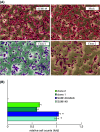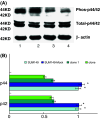Dominant-negative E-cadherin inhibits the invasiveness of inflammatory breast cancer cells in vitro
- PMID: 16932944
- PMCID: PMC12160849
- DOI: 10.1007/s00432-006-0140-6
Dominant-negative E-cadherin inhibits the invasiveness of inflammatory breast cancer cells in vitro
Abstract
E-cadherin is a transmembrane glycoprotein which mediates epithelial cell-to-cell adhesion function as a tumor suppressor and frequently loss of expression in a wide spectrum of human cancer. However, recent studies demonstrated that E-cadherin was always over-expressed in inflammatory breast cancer (IBC) specimen and cell lines, which is a clinical extreme malignancy of breast cancer. It is hypothesized that the gain and not the loss of the E-cadherin axis contributes to the IBC unique phenotype. To test this assumption, we generated dominant negative mutant E-cadherin high-expression inflammatory breast cancer cells by introduced dominant negative mutant E-cadherin (H-2kd-E-cad) cDNA into human IBC SUM149 cells. Our studies demonstrated that the ability of invasion of SUM149 cells was significantly inhibited by H-2kd-E-cad via down-regulation of MMP-1 and MMP-9 expression. The underlying signal pathway of MAPK phosphorylated Erk 1/2(P44/42) in H-2kd-E-cad-transfected SUM149 cells was significantly down-regulated compared to parental and mock contrast. Our studies provided further functional evidence as the gain of E-cadherin expression dedicated to the IBC malignant phenotype and the blockage of MAPK/Erk activation maybe a promising therapeutic target.
Figures





References
-
- Albini A (1998) Tumor, endothelial cell invasion of basement membranes. The matrigel chemoinvasion assay as a tool for dissecting molecular mechanisms. Pathol Oncol Res 4:230–241 - PubMed
-
- Alpaugh ML, Tomlinson JS, Shao ZM, Barsky SH (1999) A novel human xenograft model of inflammatory breast cancer. Cancer Res 59:5079–5084 - PubMed
-
- Amagai M, Fujimori T, Masunaga T, Shimizu H, Nishikawa T, Shimizu N et al (1995) Delayed assembly of desmosomes in keratinocytes with disrupted classic-cadherin-mediated cell adhesion by a dominant negative mutant. J Invest Dermatol 104:27–32 - PubMed
-
- Birchmeier W, Behrens J (1994) Cadherin expression in carcinomas: role in the formation of cell junctions and the prevention of invasiveness. Biochim Biophys Acta 1198:11–26 - PubMed
-
- Braga VM (2002) Cell–cell adhesion and signalling. Curr Opin Cell Biol. 14:546–556 - PubMed
Publication types
MeSH terms
Substances
LinkOut - more resources
Full Text Sources
Medical
Miscellaneous

